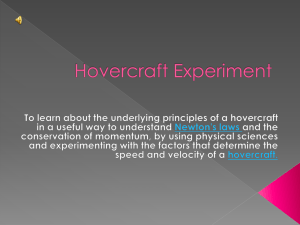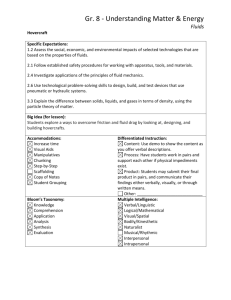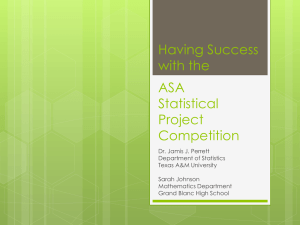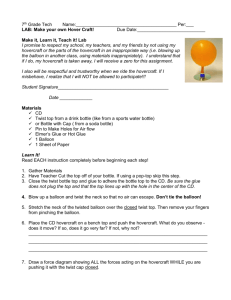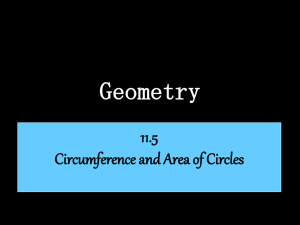Hovercraft - Shades of Blue
advertisement
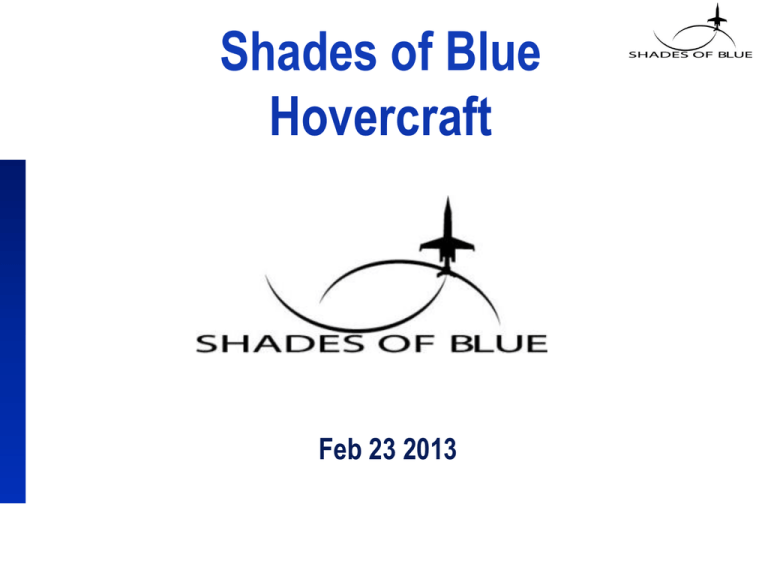
Shades of Blue Hovercraft Feb 23 2013 Agenda • • • • • • Terms and Concepts What is a Hovercraft? Questions Experiment Set Up Compile Results Conclusion 2 Terms and Concepts • • • • • Hovercraft Air cushion Friction Volume Ground Effects 3 What is a Hovercraft? • Vehicle that glides over a smooth surface – Hovers upon an air cushion – Also called Air-Cushion Vehicle (ACV) • How is the air cushion made? – Slow-moving, low pressure air that is pushed downward against the surface below the hovercraft – Use of fans to create the air – Flexible skirt (curtain) surrounding base traps the air current • How do you steer a hovercraft 4 Principle of a Hovercraft The Propellers (1) are used to propel the hovercraft forward, but also used to drive the fans (3) through which air is sucked (2), forcing the skirt (4) to billow out, and the hovercraft to float above the ground. Hovercraft Film • http://www.youtube.com/watch?v=BvzetZSxuIc • http://www.youtube.com/watch?v=kwC8MP6uOiQ • http://www.youtube.com/watch?v=vqAAEHgN5zk • http://www.youtube.com/watch?v=e1xDkmd0qFY 6 Let’s Experiment • Materials – Pop-top lid from a plastic drinking bottle. (Reusable plastic drinking bottles sometimes use these kinds of lids.) – A CD or DVD – Craft glue or Super Glue – Measuring Device – A medium-size balloon (should be able to inflate up to at least 30 inches) – Stopwatch or timer – Large flat surface for testing the hovercraft 7 Preparation • Remove a pop-top lid from a plastic drinking bottle. • Glue the base of the lid to the CD (or DVD) so that the lid covers the hole in the center. Use caution, and follow all of the instructions and safety warnings on the packaging. • Allow the glue to dry completely. 8 Roles • • • • • Team Lead Person to inflate balloon Person to measure Time Keeper Recorder 9 Procedure – Blow the balloon up to the desired size as shown on the marked yarn (2nd mark 30” circumference, 1st mark 20” circumference), then pinch the neck so that no air can escape. – Stretch the neck of the balloon over the pop-top lid, being careful not to let any air escape. Carefully center the balloon's opening above the pop-top lid opening. Your completed hovercraft should have CD flat on the bottom, pop-tip lid above and the inflated balloon's neck stretched snugly around the closed lid. – Your hovercraft is now ready to do some hovering! 10 Instructions • Place the hovercraft on a flat surface. Start your stopwatch or timer, open the pop-top lid and push the hovercraft. Stop the stopwatch when the hovercraft stops hovering. – Write down how long the hovercraft hovered • Detach the balloon from the pop-top lid. • Repeat this process two more times, inflating the balloon as large as you safely can, reattaching it to the pop-top lid, and timing how long the hovercraft hovers. • Calculate the average of the three test cases 11 Instructions • Repeat this process three more times, but this time only inflate the balloon to the first mark (20”). • How long did the CD hover using the 30” circumference inflated balloon? Did the craft hover for about the same amount of time each of the three times you tested it using a small balloon? • What about the 20” circumference? 12 Capture Your Results Trial Circumference 30 inches Circumference 20 inches #1 #2 #3 Average Time Air Volume 13 Estimate Volume of Air in Balloon • The formula for the volume of a sphere is traditionally given as a function of the radius. However, in practical applications, it is not always easy to determine the diameter or radius of a round object. • The circumference of a ball of sphere is much easier to measure. Simply wrap the pre-marked yarn around the widest part of the sphere (the equator) . And since the circumference and radius are related by a simple formula, you can then determine the radius of the object, and finally the volume. 3 14 Equation for Volume The Equation for Volume in Terms of the Circumference • First recall the formulas for volume (v) and circumference (c) in terms of the radius (r). • v = (4/3)πr3 • c = 2πr • If you solve the second equation for r, you get • c/(2π) = r • Now plug this into the volume equation. That is, you replace r with the expression c/(2π). • v = (4/3)π[c/(2π)]3 • = (4/3)π[c3/(8π3)] • = c3/(6π2) 15 Equation for Volume The Equation for Volume in Terms of the Circumference • First recall the formulas for volume (v) and circumference (c) in terms of the radius (r). • v = (4/3)πr3 • c = 2πr • C=30” • If you solve the second equation for r, you get • c/(2π) = r • Now plug this into the volume equation. That is, you replace r with the expression c/(2π). • v = (4/3)π[c/(2π)]3 • = (4/3)π[c3/(8π3)] • = c3/(6π2) • =27000/59.15 • =456 cu inches of air 16 Now Let’s Solve it for a 20” Circumference The Equation for Volume in Terms of the Circumference • First recall the formulas for volume (v) and circumference (c) in terms of the radius (r). • v = (4/3)πr3 • c = 2πr • C=20” • If you solve the second equation for r, you get • c/(2π) = r • Now plug this into the volume equation. That is, you replace r with the expression c/(2π). • v = (4/3)π[c/(2π)]3 • = (4/3)π[c3/(8π3)] • = c3/(6π2) • = c3 /59.15 • =8000/59.15 • =135 cu inches of air 17
